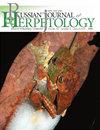Immunolocalization of the EDWM-Protein Indicates a Matrix Role in Cornification of Lizard Epidermis
IF 0.9
4区 生物学
Q3 ZOOLOGY
引用次数: 1
Abstract
During epidermal differentiation in the scales of lizards and snakes, from the basal layer beta- and later alpha-keratinocytes are generated to form beta-and alpha-corneous layers. In the lizard Anolis carolinensis, minor proteins derived from the EDC (Epidermal Differentiation Complex) are added to the main constituent proteins, IFKs (Intermediate Filament Keratins) and CBPs (Corneous Beta Proteins, formerly indicated as beta keratins). One of these proteins that previous studies showed to be exclusively expressed in the skin, EDWM (EDC protein containing high GSRC amino acids) is rich in cysteine and arginine, amino acids that form numerous –S–S– and electro-static chemical bonds in the corneous material. Light and electron microscopy immunolbeling for EDWM show a diffuse localization in differentiating beta-cells and in some alpha-cells, in particular those of the clear-layer, involved in epidermal shedding. The study suggests that EDWM may function as a matrix protein that binds to IFKs and CBPs, contributing to the formation of the specific corneous material present in beta- and alpha-corneous layers. In particular, its higher immunolocalization in the maturing clear layer indicates that this protein is important for its differentiation and epidermal shedding in A. carolinensis and likely also in other lepidosaurian reptiles.edwm蛋白的免疫定位表明在蜥蜴表皮凝聚过程中起基质作用
在蜥蜴和蛇的鳞片表皮分化过程中,从基底层产生-和后来的α -角质形成细胞,形成-和α角质层。在蜥蜴中,EDC(表皮分化复合体)衍生的次要蛋白被添加到主要组成蛋白中,ifk(中间丝角蛋白)和CBPs(角质层β蛋白,以前被称为β角蛋白)。先前的研究表明,EDWM(含有高GSRC氨基酸的EDC蛋白)是这些蛋白中的一种,它富含半胱氨酸和精氨酸,这些氨基酸在角膜材料中形成许多-s -s -和静电化学键。光镜和电镜下EDWM的免疫反应显示,在分化的β细胞和一些α细胞中,特别是那些参与表皮脱落的透明层细胞,具有弥漫性定位。该研究表明,EDWM可能作为一种结合ifk和CBPs的基质蛋白,有助于形成存在于-和-角质层中的特定角质层物质。特别是,它在成熟透明层中较高的免疫定位表明,该蛋白对卡罗林蛙的分化和表皮脱落很重要,可能在其他鳞翅目爬行动物中也很重要。
本文章由计算机程序翻译,如有差异,请以英文原文为准。
求助全文
约1分钟内获得全文
求助全文
来源期刊

Russian Journal of Herpetology
ZOOLOGY-
CiteScore
1.70
自引率
0.00%
发文量
29
期刊介绍:
Russian Journal of Herpetology is an international multi-disciplinary journal devoted to herpetology. Russian Journal of Herpetology accepts original papers on ecology, behavior, conservation, systematics, evolutionary morphology, paleontology, physiology, cytology and genetics of amphibians and reptiles.
Types of Contributions:
-original papers
-invited or contributed reviews on specific topics
-short communications on topics of immediate interest, new methods and ideas in progress
-notices of meetings, symposia, and short courses
-book reviews
 求助内容:
求助内容: 应助结果提醒方式:
应助结果提醒方式:


